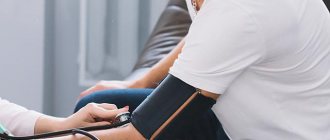Hypertension is one of the most common diseases of the cardiovascular system. The pathology affects about a quarter of the adult population of the planet. Athletes who train daily cannot always boast of ideal blood pressure levels. Loads associated with lifting weights have a particularly negative effect on the condition of blood vessels and the heart muscle. Therefore, for many men and women who dream of a beautiful body, the question of how hypertension and bodybuilding are interrelated is relevant.
When can you suspect hypertension?
Blood pressure readings within the range of 110-135 mmHg (systolic), 70-110 mmHg (diastolic) are considered normal for adults. Exceeding these numbers, detected during measurement, indicates a problem.
In the initial stages of hypertension, doctors advise patients to exercise. Fitness for hypertension must be combined with diet therapy, correction of the daily routine, and avoidance of alcohol and caffeine-containing drinks. This helps train the heart muscle and strengthen the vascular walls.
There are often cases when a person devotes a lot of time and effort to sports and does not even suspect that he has high blood pressure. Bodybuilders are actively involved in bodybuilding, preparing for competitions, and taking dietary supplements. They often attribute changes in well-being to fatigue and stress. However, there are signs that you should pay special attention to:
- sudden attacks of nausea;
- dizziness;
- tinnitus;
- heaviness in the back of the head;
- previously unusual blue circles under the eyes;
- increased sweating combined with attacks of rapid heartbeat after the end of the workout.
Even when the symptoms listed above appear, athletes set themselves the goal of quickly achieving results. They spend several hours every day on simulators. Therefore, along with increasing muscles, the condition of the heart and blood vessels worsens.
According to the observations of sports doctors, even young athletes aged 17 to 22 years, who began to train regularly with normal blood pressure levels, have already seen an increase in blood pressure throughout the year. On average, systolic pressure rises by 16-17 mmHg.
See also Grapefruit: does it increase or decrease blood pressure?
There is another feature of increased blood pressure in bodybuilders. If the increase in systolic blood pressure gradually stops, they remain at the same level, then diastolic (lower) pressure increases abruptly. It is very difficult to stabilize it, to return it to normal limits.
Bodybuilding (bodybuilding)
It has become established in society that when talking about fitness, people begin to think about bodybuilding, bodybuilding, or, for clarity, athletic gymnastics. They see the harmony of body and Spirit not so much in acquired health, but rather in hypertrophied muscles. It is very difficult to agree with this, and even more difficult to refute many established positions. After all, numerous fitness clubs and athletic halls have been opened, and specialist instructors have been trained to give the necessary advice. That is, fitness clubs, with gyms for weight training present there, have long become a concept that it would be reckless to oppose.
But let’s not become a critic - a healthy person is allowed to do a lot, even exercise with weights. The main thing is not to become a “fan”.
But a person suffering from arterial hypertension or who has a tendency to increase blood pressure should, of course, think carefully before picking up heavy discs. The fact is that all isometric exercises with static tension cause an increase in blood pressure! And if you consider that a person’s blood pressure is already rising, then food for thought appears.
And it’s especially scary because young people who use antihypertensive drugs also get rid of arterial hypertension with the help of weights. There is no other way to call this phenomenon anything other than suicide. It is important for these young guys to learn one thing: youth is a wonderful thing, but, unfortunately, temporary. And acquired hypertension cannot be compared with the resulting muscle mass, which supposedly personified health. You will acquire a disease that will be very difficult to get rid of.
31.03.2012
What is the cause of blood pressure problems?
Hypertension and bodybuilding, as well as many other strength sports, are closely related. During intense training and heavy lifting, the adrenal glands release large amounts of adrenaline into the blood. The hormone causes blood vessels to constrict. Due to this, blood pressure increases. A short-term surge in the level of this biologically active substance is not harmful to health. But long hours of daily training, accompanied by high levels of adrenaline, are the main factor in the development of hypertension in athletes.
There are other reasons for high blood pressure levels. All bodybuilders try to build muscle mass. Muscles that have increased in size must be provided with the necessary nutrients and oxygen. For this purpose, a dense network of blood vessels develops. To push blood through these pathways, the heart has to work twice as hard.
Bodybuilding exercises for hypertension should be carried out with a decrease in the number of static exercises.
Experts explain this requirement by its negative impact on the heart and vascular system. When performing exercises, a tense muscle puts pressure on the vascular walls, and the blood supply is disrupted. As a result, there is a jump in blood pressure readings.
An athlete's blood pressure may depend on his psychological state. Often, the factor that provokes an increase in blood pressure readings is the use of medications, stimulants, as well as the use of special dietary products.
What sports activities are contraindicated for hypertensive patients?
Any doctor will support the patient in his desire to exercise. If this is not the stage when bed rest is the main prescription, physical activity is allowed. And only your doctor, assessing your condition objectively, will indicate the list of areas in which you are able to realize your potential in terms of physical education.
If a patient has high blood pressure levels, he CANNOT:
- Get involved in lifting weights;
- Train in running (in particular, shuttle running);
- Do exercises to build muscles;
- In case of second degree hypertension, rhythmic gymnastics is prohibited;
- Lean forward, straining the muscles of your neck and back.
These are, of course, not all prohibitions. Running at a fast pace, running with obstacles is more of a sport than physical education. Therefore, the most correct thing that a doubtful hypertensive patient can do is to take referrals for physical therapy classes. There is a focus on maintaining the health of patients with existing diseases, including a group for people with high blood pressure.
Training Recommendations
Don’t think that hypertension and the gym are incompatible things. It is quite possible to achieve results without losing your health. To do this, sports medicine specialists recommend reviewing the regimen and intensity of the training process, and making adjustments to the training program on simulators.
Athletes whose blood pressure levels exceed the norm are prohibited from performing certain types of exercise. These include:
- dumbbell push-ups, barbells in a lying position;
- bench press, in which the main load falls on the legs;
- lifting a barbell, weights, dumbbells held between the legs with two hands;
- squats, in which the load is held on the back, chest;
- exercises for which the athlete has to lower his head below his body.
Attention! It is worth giving up eating sweet foods shortly before starting a workout: along with an increase in blood glucose levels, blood pressure rises.
You can make your training as effective as possible if you follow the recommendations of sports medicine specialists:
- The training should begin with an aerobic warm-up, and each session should end with the same complex.
- It is necessary to alternate exercises aimed at developing different muscle groups, gradually reducing their intensity.
- It is important to pause between approaches for at least one and a half minutes.
- Maintaining a breathing rhythm helps keep blood pressure normal. When you relax, you need to inhale, when you tense up, you need to exhale. There should be no holding your breath.
- Hypertensive patients need to reduce the number of approaches and exercises performed.
- Immediately after finishing your workout, you need to stand in a warm shower for 5-7 minutes.
See also Increased blood pressure during pregnancy
The training regimen of a bodybuilder suffering from hypertension should be structured in such a way as to reduce to a minimum the amount of adrenaline entering the blood. Exercises on power machines, as well as using barbells and dumbbells, contribute to the development of the muscular system. Aerobic complexes strengthen the heart, blood vessels, and lungs. If you evenly combine these types of training, the pressure will gradually normalize and the general condition of the body will improve.
Fitness for diabetes
A certain percentage of hypertensive patients, in addition to elevated blood pressure, also have diabetes mellitus. Is it permissible for a diabetic to engage in fitness to maintain health? It is definitely possible and necessary.
Fitness rules for diabetics with hypertension:
- An endocrinologist-diabetologist should not only know that you are engaged in fitness, he is the consultant who will suggest the regime and type of exercise. Preliminary coordination of your actions with the treating doctor is not even discussed.
- Monitor your sugar levels. Physical education will reduce alarming indicators, since during strength training the muscles actively consume glucose. This means that the doctor will have to reduce the insulin dose. And to make it clear how to do this correctly, a diabetic measures his sugar level, of course, on an empty stomach, before training and half an hour after it. These indicators are recorded in the diary.
- The load increases smoothly. Beginners start with classes for 7-10 minutes, nothing more. Gradually, the training time will increase to 35-40 minutes. And you need to train quite often, 4-5 times a week.
- Follow your feelings. Based on your controlled sugar level, it will be clear whether you need to exercise today or not. If during exercise, pain and heaviness appear in the chest, as well as headache and dizziness, if shortness of breath appears, stop training.
- Don't quit your studies. The success of physical activity lies only in its regularity. If you take a serious break, then all the positive effects of the classes will quickly disappear.
Choose the optimal fitness direction. Yoga, swimming, Pilates, and walking are considered suitable activities; strength training should be very gentle, or it is better to avoid them altogether.
General recommendations
Eating certain types of foods rich in the amino acid L-tryptophan helps to relax the nervous system and reduce the body’s saturation with adrenaline after an active workout. These include:
- chicken, turkey fillet (breast);
- milk;
- dairy products;
- hard cheeses;
- soya beans;
- sesame seeds;
- peanut;
- pine nuts, walnuts;
- fresh river and sea fish;
- lean pork, beef.
Immediately after finishing your workout, it is useful to eat a handful of nuts or another product from the list. In order for the amino acid to be well absorbed, it is worth adding to your snack food that contains simple carbohydrates, magnesium, and iron. For example, a small cereal bar, a piece of dark chocolate, a glass of orange or other freshly squeezed fruit juice.
A visit to the shower or sauna at the end of the lesson should be dosed. You should enter a hot room (stand under running water) for a short time (3-5 minutes). The frequency of hot procedures is 2-3 times.
Listening to calm music has a relaxing effect. Therefore, athletes are recommended to add classical works to the playlist along with stimulating melodies.
Compatibility of hypertension and sports
Every doctor draws a person’s attention to the fact that leading an active lifestyle always brings benefits. When diagnosing hypertension, you need to clarify which sport is best suited. In this case, the load is increased gradually. The training takes place taking into account the individual preferences of the body.
There are often cases when the basis of treatment is not medication, but physical exercise. Parallel use with herbal teas and other folk remedies treat the disease to some extent. This not only reduces increased arterial tone, but also strengthens the heart muscle. Before playing sports, be sure to consult a specialist.
Types of sports and their benefits
To improve the general condition of the body, hypertension allows you to use the following exercises:
- Breathing exercises.
- Run at a minimal pace. It's more about walking.
- Water sports - gymnastics, aerobics or football.
- Slow push-ups.
- Ski walking.
- Muscle stretching.
Exercises in the gym are allowed, but on certain machines. As soon as people hear the word “rocking chair,” a person lifting weights appears before their eyes. But we are not talking about bodybuilding. Light exercises, previously agreed upon with the doctor, are considered. In case of stage I hypertension, pull-ups are not prohibited.
Exercise has a positive effect on the body. It is done immediately after waking up in the morning, without getting out of bed. You should start with circular movements of the hands, extension and bending of the elbows and knees. The most effective exercise is considered to be the “bicycle” exercise in a lying position with your arms spread to the side.
Many people underestimate the effect of walking on the body, especially with hypertension. You should start with walks, walking no more than 3 km per week. Monitor your pulse so that it does not exceed 120 beats per minute. The best time for a walk is in a park or square. If possible, walk along the river, but avoid sharp climbs uphill.











